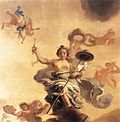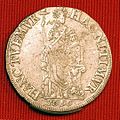
The Dutch Maiden (Dutch: Nederlandse Maagd, Latin: Belgica or Belgia) is a national personification of the Low Countries and - sometime after the secession of the Southern Netherlands - solely of the Dutch Republic, and its successor state the Netherlands. [1] She is typically depicted wearing a Roman garment and with a lion, the Leo Belgicus, by her side. In addition to the symbol of a national maiden, there were also symbolic provincial maidens and town maidens.
Contents
- 19th-century and later
- Maiden as a provincial or town symbol
- Maiden of Dordrecht
- Gallery
- References
- External links
The Dutch Maiden has been used as a national symbol since the 16th century. During the Dutch Revolt, a maiden representing the United Provinces of the Netherlands became a recurrent theme in allegorical cartoons. In early depictions she may be shown in the "Garden of Holland", a small garden surrounded by a fence, recalling the medieval hortus conclusus of the Virgin Mary. On 25 May 1694, the States of Holland and West Friesland introduced a uniform coin design for the United Provinces, showing a Dutch Maiden leaning on a bible placed on an altar and holding a lance with the cap of liberty, the Liberty pole. [2] [3]

Initially carrying a martyr's palm, by the late 17th century she often carries a cap of liberty on a liberty pole, though the hat is a conventional male style for the period, rather than the Phrygian cap that later images of liberty personified in other countries used.[ citation needed ] Alongside the type of depiction with a liberty pole, which is usually costumed in more or less modern styles, images in the Baroque classical dress that was more conventional for such personifications are also found.













